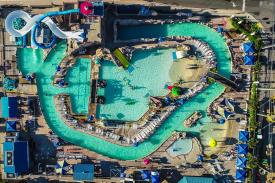Naval Research Laboratory - Chesapeake Bay Detachment
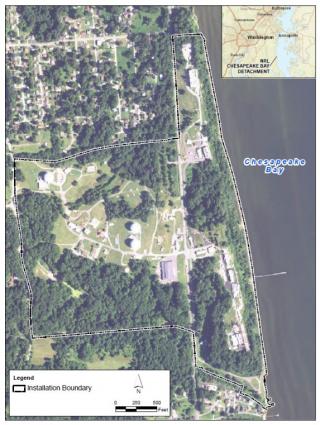
The Navy Research Laboratory Chesapeake Bay Detachment (NRL-CBD) is conducting environmental mitigation efforts at their facility, located at 5813 BAYSIDE RD CHESAPEAKE BEACH 20732, just south of the Town limits. Site 10, also referred to as the Fire Testing Area (FTA), is located on the western portion of NRL-CBD. Since approximately 1968, the FTA has been used to test extinguishing agents on fires started with various fuel sources.
The tests were conducted by creating a fire on a concrete testing pad and testing fire suppressants, including aqueous film-forming foam (AFFF), potassium bicarbonate, halons, and protein foam. Typically, wastewater containing these solutions was drained into a gravel-lined collection pit and allowed to infiltrate into the soil. In the mid-to-late 1980s, several improvements were made to Site 10, including a new testing pad, a concrete-lined collection pit, and new conveyance piping from the FTA structures to the new collection pit.
More recently, the Navy has been investigating the FTA for per- and polyfluoroalkyl substances (PFAS) due to the historical use of AFFF at the site. A groundwater investigation conducted in 2017 confirmed that PFAS were present on base in the shallow aquifer. Based on the recommendations of the 2017 study, additional sampling was proposed. The FTA is currently in the Site Inspection phase, and additional sampling for soil, groundwater, surface water, and sediment was conducted in Fall 2020.
The Site Inspection Report released on June 2022 is available here. All site-specific information released by the NAVY can be viewed here.
The September 2022 Remediation Advisory Board Meeting slides are available here.
Fish advisories managed by the Maryland Department of Environment are available here.

The Town of Chesapeake Beach response: In response to recent environmental restoration conversations and mitigation at the NRL-CBD, the Town of Chesapeake Beach has taken additional precautionary measures to test the Town’s drinking water. The Town’s drinking water has no traces of per-and polyfluoroalkyl substances (PFAS). Tests were conducted on all Town drinking wells, which draw from the Aquia Aquifer. Additionally, the Town has taken voluntary measures to test the Chesapeake Beach Water Reclamation Treatment Plant (CBWRTP) effluent, the Bayfront Park swimming water, and tissue from oysters and fish.
Results of Voluntary PFAS Testing Conducted by the Town of Chesapeake Beach: Tests were conducted for the information purposes of Town residents and the general public.
All independent reports listed below have been completed by the Town of Chesapeake Beach, conducted by a third-party approved lab, and provided to MDE for interpretation and recommendation. There has been no recommendation to implement any advisories based on the information provided at this time; however, the Town will continue to update the public with new information.
Town of Chesapeake Beach drinking water report.
Maryland Department of Environment drinking water report.
Town of Chesapeake Beach Bayfront Park swimming water report. The Maryland Department of Environment (MDE) determined that the ranges shown in the news, are consistent with other areas of the Bay.
The map below illustrates the testing location where samples were drawn at the Town-owned Bayfront Park.
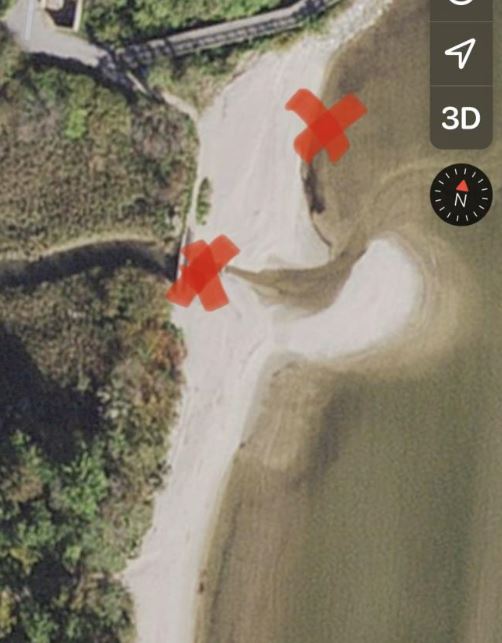
Chesapeake Beach Water Reclamation Treatment Plant effluent report. * MDE is aware of the wastewater data from the Town of Chesapeake Beach, and efforts are underway to understand potential wastewater PFAS sources, discharges better and receiving water impacts across Maryland. PFAS are a large class of chemicals with multiple uses in many products, which may or may not contribute to their presence in wastewater. No action is required of the Town related to the Water Reclamation Treatment Plant, and the Plant continues to meet all requirements of our permit.
Town of Chesapeake Beach aquatic life tissue sampling report: Oyster report. MDE has stated that the reported results from the oyster tissue analysis from Chesapeake Beach indicate that the levels are below risk-based consumption screening criteria for PFOA and PFOS derived and said in the MDE 2020 St. Mary’s River Pilot Sampling Program (https://mde.maryland.gov/programs/Water/FishandShellfish/Pages/StMarys_PFAS.aspx). The reported oyster tissue results at Chesapeake Beach are at the functional limits of the analytical methodology and are similar to the March 2020 St. Mary’s study results. The effects at Chesapeake Beach were detected below the lab reporting limit value of 0.56 ug/kg, and the reporting limits were similar to the March 2020 St. Mary’s Study laboratory reporting limits for PFOS and PFOA of ~ 0.9 ug/kg.
Fish report EPA has not issued risk-based criteria for PFOA or PFOS in fish. MDE has not yet published risk-based screening levels for PFOA + PFOS in fish; these values are currently under development. However, recognizing the level of public interest and potential concern of the community, MDE has completed calculations to help interpret the reported results from this site. Working from the town’s reported results in fish tissue, the table below shows measures MDE has completed to assist in the interpretation of the results from this site.
MDE calculated risk-based screening levels for PFOA + PFOS in the consumable portions of fish, representing a site-specific evaluation of risk-based screening criteria for fish consumption. The table includes a range of possible consumption amounts that include both the standard value MDE has traditionally used in its fish advisory program and higher intensity consumption amounts. The table also provides information for adults as well as children. MDE utilized the EPA toxicity values for PFOA and PFOS from the EPA May 2021 RSL table in developing these values.
The concentrations of PFOA+PFOS in striped bass and white perch reported by Chesapeake Beach -- about 1.5 ug/kg in striped bass and PFOA + PFOS levels between 7-10 ug/kg in white perch -- were below the site-specific screening criteria (the far right column in the table) for even the most sensitive of populations at the higher assumed levels of consumption. However, we still have to keep in mind the caveats listed above.
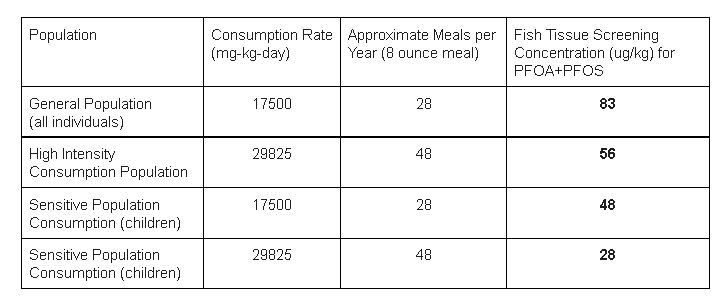
MDE plans to conduct additional sampling in the Fall of 2021 in broad regions of the Chesapeake Bay and focused areas.
The below map illustrates a red "X" at the coordinates where the oysters were collected and a black "X" where the fish were collected.
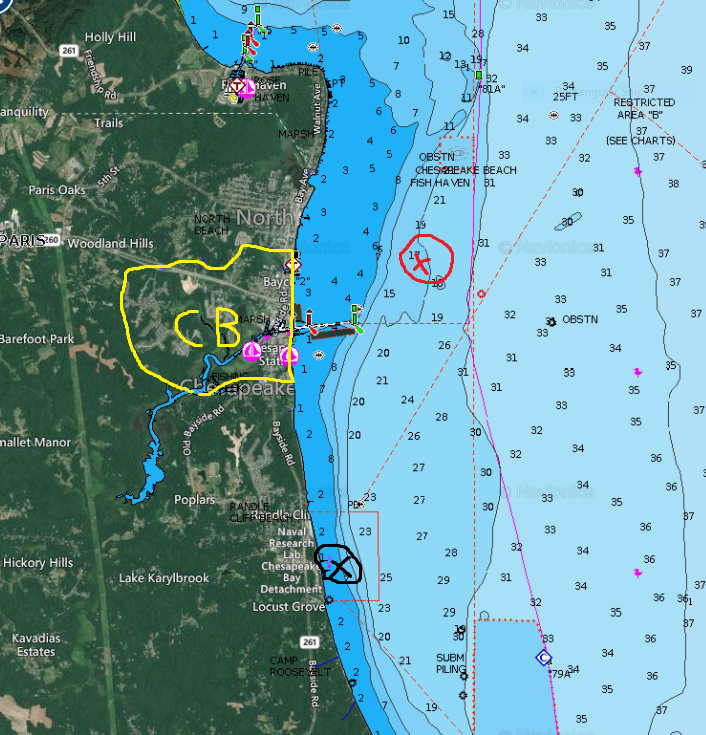
*It is important to note that the Chesapeake Beach Water Reclamation Treatment Plant (CBWRTP) receives influent from the Town of Chesapeake Beach, Town of North Beach, Anne Arundel County, and Calvert County.
MDE recently completed a study called the "St. Mary’s River Pilot Study of PFAS Occurrence in Surface Water and Oysters September 2020" to view the report.
To view a list of approved labs for testing, please click here.
Office of the Environment Health and Safety report on "Per- and Polyfluoroalkyl Substances (PFAS) Awareness" click here to view.
What is PFAS? According to the Environmental Protection Agency (EPA), “PFAS are a group of artificial chemicals that have been in use since the 1940s and are (or have been) found in many consumer products like cookware, food packaging, and stain repellants. PFAS manufacturing and processing facilities, airports, and military installations that use firefighting foams are some of the main sources of PFAS. PFAS may be released into the air, soil, and drinking water sources. PFOA and PFOS are the most studied PFAS chemicals and have been voluntarily phased out by industry, though they are still persistent in the environment.”
Why is the Town testing for PFAS? Given the Naval Research Laboratory - Chesapeake Bay Detachment's proximity to Town, being just south of the Town limits, the Town has been engaged with the Navy regarding their ongoing PFAS containment measures. The Navy has provided the Town and general public with data supporting their determination of why the Town’s water supply was not considered at risk of PFAS exposure. The Town Administration agreed with the Navy’s assessment; however, it felt it was important to conduct testing to assure Town citizens of the safety of municipal drinking water. The testing conducted by the Town, and at the Town’s expense by a third-party approved lab, is above and beyond what is required of any Maryland Department of Environment (MDE) mandatory testing.
The Navy conducted sampling of private wells that were considered at risk of PFAS exposure; all locations were outside of Town limits. The Navy made contact with local affected property owners and held a public meeting and poster session in July 2018 before sampling and again in October 2018 after sampling to provide a summary of the results to the public. The Navy sent individual property owners their private well sampling results. Of the 42 drinking water samples collected from private wells, PFAS were not detected in 39 pieces. PFAS was detected in 3 models. PFOA was seen in 2 of these samples. No test results were above the EPA lifetime health advisory. Further information related to the Navy’s testing can be located here.
Who provides regulatory oversight of the Naval Research Laboratory? Regulatory oversight of the Naval Research Laboratory – Chesapeake Bay Detachment is provided by the Maryland Department of the Environment (MDE).
What Community Outreach is taking place? The Naval Facilities Engineering Systems Command (NAVFAC) Washington, in cooperation with the Maryland Department of the Environment (MDE), has established a Restoration Advisory Board (RAB) to discuss environmental restoration issues at Naval Research Laboratory – Chesapeake Bay Detachment (NRL-CBD). The RAB contains Navy, Maryland Department of ththe e Environment (MDE) representatives, local government officials, and community members. The NRL-CBD RAB was formed in December 2019. The RAB is co-chaired by an elected community member and a Navy representative. RAB members are considered a key source in efforts to communicate openly and effectively with the community. They are provided information about the ER Program, and their input on remediation decisions is actively sought.
The purpose of a RAB is to encourage regular, two-way communication between the Navy and the local community by:
- Informing the public regarding the progress of planned and ongoing restoration actions at the facility
- Communicating the results of investigations and risk assessments when available
- Receiving feedback from the public as to their specific concerns and information needs
- Providing the public with the opportunity to comment on and participate in addressing technical decisions associated with ER sites at the facility
Further information related to future outreach efforts can be viewed here on the Naval Research Laboratory - Chesapeake Bay Detachment public outreach websitehere.
The Town will continue coordinating with the Navy and Maryland Department of Environment representatives and disseminate information to Town citizens.
For more information about the Naval Research Laboratory - Chesapeake Bay Detachment, please contact Regina Adams, NAVFAC Washington Public Affairs Officer, at 202-685-0384 or NAVFAC_NFW_PUBLICAFFAIRSOFFICE@navy.mil.

